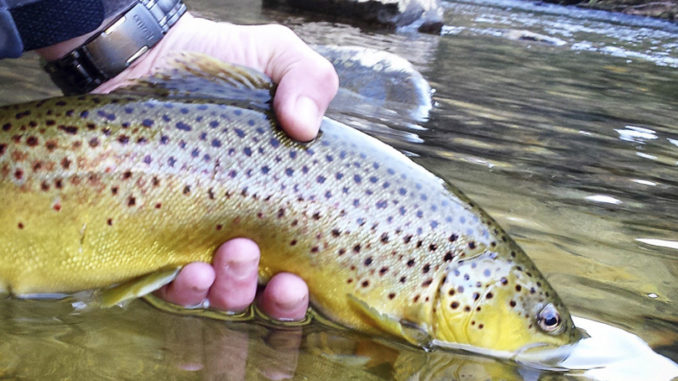
Blue-ribbon trout stream covers 52 steep miles
One of the five largest and longest free-flowing rivers in the Southeast, the Chattooga begins its 52-mile journey below Whiteside Mountain in Jackson County near Cashiers, N.C. From there, it flows south, entering the Nantahala National forest below Cashiers Lake. After leaving North Carolina, the river forms the border between South Carolina and Georgia, flanked by the Sumter National Forest in South Carolina and the Chattahoochee National Forest in Georgia. It offers a variety of trout fishing experiences before entering Lake Tugalo in northeastern Georgia.
It earned designation as a National Wild and Scenic River in 1974. Trout Unlimited rated it as one of the top 100 trout streams in the nation. Depending on which section you’re fishing, the Chattooga is regulated as wild trout waters, delayed-harvest waters and general waters.
The 10-mile section of the Chattooga in North Carolina is exclusively wild brown trout country and is regulated as wild trout/natural bait waters. Best access to this area is off NC 107 south of Cashiers to Bullpen Road. The river is a short hike from a state-maintained parking lot.
This river gets big kudos from local guides
Marc Hipp, a guide for Brookings Anglers in Cashiers, said, “The Chattooga is one of my favorite places to fish.”
He rates it 10 on a scale of one to 10, particularly in the spring and fall.
“During the summer,” he said, “I’d give it a rating of five to seven.”
The majority of the browns range from nine to 14 inches. And some anglers report catches weighing 5 pounds or more. Hipp’s largest is a 25-incher.
The South Carolina portion is wild brown trout waters in the upper section from the North Carolina border to Big Bend Falls. Much of the fishable portion flows through the Ellicott Wilderness. Anglers gain access by hiking trails from the Walhalla State Fish Hatchery and Burrells Ford Bridge Road off SC 107.
Regular stockings keep a healthy population in the river
SCDNR stocks the section from Burrells Road to Reed Creek once a year with approximately 25,000 rainbow and brown trout fingerlings. When mature, these fish provide a fishing experience as close to wild trout as can be found anywhere in the river. The fingerlings are released from a helicopter, Access to this area is by foot trail from the parking lot at the SC 28 bridge, Thrift Lake Access and Big Bend Road.
From Reed Creek to SC 28, the river is stocked with brook, rainbow and brown trout. Here, it is regulated as delayed-harvest waters, with catch-and-release rules in effect from Nov. 1 to May 14. During the delayed-harvest season, only artificial lures or flies with single hooks may be used. During the catch-and-keep season, the daily creel limit is five trout with no size or bait restrictions.
Creel limits for South Carolina and Georgia are five trout per day. Either a South Carolina or Georgia license is valid for fishing waters in both states. North Carolina does not have a reciprocal license agreement with the other two states.
The Chattooga River Trail follows the river for more than 30 miles, offering access to much of the river. Some sections of the river run far below the trail, especially in the gorge or narrows section. Hipp does not recommend fishing this part of the river alone.
“It’s extremely difficult to reach and to fish,” he said, “Plus, you can’t get a cell-phone signal.”
Many fly patterns will work on this river
Hipp recommends a variety of flies for fishing the Chattooga.
“In the spring, you’ll see good hatches of Quill Gordons, Light Cahills and Blue Winged Olives,” he said. “In late spring and into summer, I’ll fish with a Sulphur or Yellow Sally.” Best sizes run from 16 to 12.
“Trout will hit a Quill Gordon or Sulphur like crazy,” Hipp said.
For nymph fishing, he prefers a Pheasant Tail, Hare’s Ear, Zug Bug or Prince in sizes 18 to 12.
For big water, Kaufman Stone, Pat’s Rubber-Legged Stone and large sculpin patterns such as the Sculpzilla are very effective.
Although the Chattooga is best known for its big brown trout, the river does occasionally yield some large rainbow and brook trout. A 4-pound, 10-ounce brook trout was caught below Burrells Ford in 2010, setting a South Carolina record.
The river is one of the top destinations in the Southeast for paddling sports. That’s especially true in the South Carolina and Georgia sections, dating back to the 1972 movie, Deliverance.




Hi Robert. I’m making a trip up to the Chattooga in a few weeks and have a question. In the article it says the creel limit for SC and Ga is eight. SC DNR requlation book says the creel is five. Can you tell me what I’m missing? Eight per day is much better than five.
Thanks for your question. The article you read was an archived article from 2016, when the limit was eight. It is now five, and we have changed the article to reflect the latest regulations. Thanks for pointing that out to us. Send us some photos of what you catch!
will do…thanks for all you guys do…love my subscription…